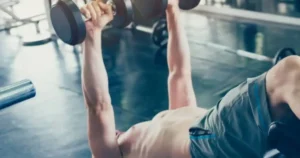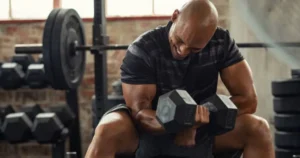Not only for sports performance but also for daily functional fitness, a strong lower body is vital. A flexible, quick, and adaptable approach to target your lower body muscles is dumbbell leg workouts. This book provides clear ideas, practical advice, and professional recommendations regardless of your level of experience—from seasoned lifters trying to perfect their program to beginners wishing to explore strength training. In this post, we will discuss the advantages of dumbbell leg workouts, basic equipment, thorough exercise instructions, customized routines for men and women, typical mistakes to avoid, safety considerations, and more.
Table of Contents
Introduction: Why Would One Choose Dumbbell Leg Exercises?
A potent approach for increasing general fitness, strengthening muscles, and improving stability is dumbbell leg workouts. They provide the ease of adjustable resistance and let you engage several muscular groups, including your quadriceps, hamstrings, glues, and calves. Furthermore, a space-efficient solution that performs great in home gyms and business workout centres is dumbbells.
Main Advantages:
- Target and activate important lower body muscles for balanced growth.
- Improve functional strength to support daily tasks by means of endurance.
- Functional fitness helps with coordination, stability, and balance.
- Convenience: Simple to include in any minimal equipment exercise environment.
Whether your objectives are for glute development, leg toning, or total lower body strength, you may customize your training by combining a range of exercises, including dumbbell squats, lunges, and deadlifts.
Advantages of dumbbell Leg exercises
Strength and Development of Muscles
- Particularly in the quadriceps, glutes, and hamstrings, the resistance offered by dumbbells stimulates muscle hypertrophy.
- Regular dumbbell exercise increases functional strength, which is valuable for daily chores and sports performance.
Functional Approach to Exercise
- Using stabilizing muscles in activities like dumbbell lunges improves general balance.
- Training the mind-body link and multi-joint workouts such as dumbbell squats are needed for coordination.
simplicity and adaptability
- Just a pair of dumbbells will allow you to perform a complete lower-body workout.
- Beginners, intermediate, or advanced fitness levels can all be simply altered by exercises.
Basics for Dumbbell Leg Exercises
Types of Dumbbells
- Usually suitable for most exercises, standard dumbbells come in set weights.
- Ideal for progressive overload, adjustable dumbbells let you change weights as you get better.
Extra Accessories
- Workout mat for floor exercises: comfortable design.
- Resistance bands provide variation and additional movement resistance or aid.
- Good for step-ups and split squats, it is a sturdy bench or step.
Warm-up Activities: Dynamic Leg Stretching
Warming up is essential to prevent damage and enhance performance in your dumbbell leg exercise. Try these energetic stretches:
- Front-to-back and side-to-side leg swings
- Walking Lunges: Advance range of motion gradually.
- High knees help you to raise your heart rate and stimulate the hip flexors.
- Warm the glues and quadriceps in bodyweight squats.
Comprehensive Exercise Library
Here is a detailed review of fundamental dumbbell leg workouts, together with modifications and advice on correct form.
1. Squats using dumbbells
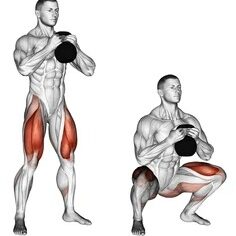
Variants:
- For further core exercises, hold a dumbbell at chest level in a goblet squat.
- Keep the dumbbells at shoulder height to focus the quads in front squats.
Guideline:
- Straight your back and raise your chest.
- Use your core all through the motion.
2. Lunches with dumbbells
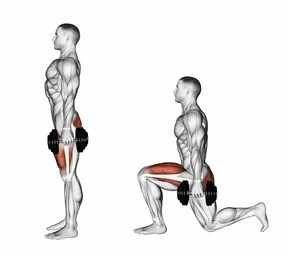
Variances:
- To work the quadriceps, step straight ahead.
- Step backwards for a softer knee impact in reverse lunges.
- To work the inner and outer thighs, step sideways.
Advise:
- Continue a cautious fall.
- To prevent strain, keep your knee running parallel to your ankle.
3. Deathlifts from Romania (RDLs)
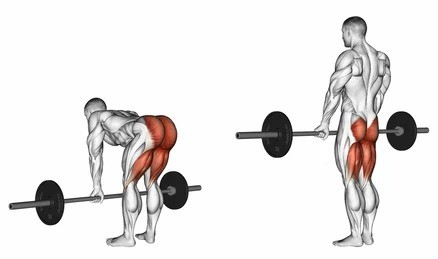
Prioritize glute and hamstring activation.
- Executing, keep the dumbbells close to your thighs and hinge at the hips with a small bend in your knees.
Suggestions:
- Make sure your spine is neutral.
- Lower carefully and squeeze your glutes at the top.
4. Deadlifts Using dumbbells
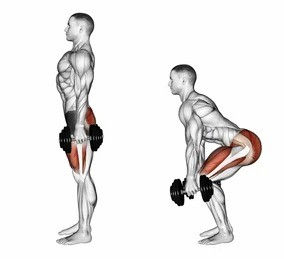
Varieties:
- The typical form for general lower body strength is the conventional deadlift.
- Wider stance to concentrate more on the glues and inner thighs in sumo deadlifts.
Advise:
- Maintaining shoulder-width apart feet will help.
- Using your legs, not your back, engage your core and lift.
5. Step-upped dumbbells
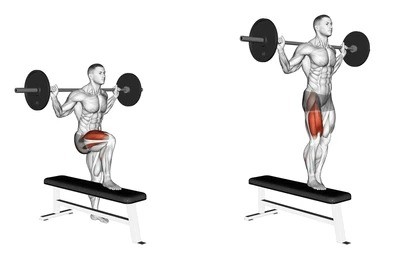
Perfect for balance and single-leg strength.
- Driving through your heel, step onto a bench or strong platform.
Guideline:
- Keep a good posture.
- Balance training calls for alternate legs.
6. Calcium Raises using dumbbells
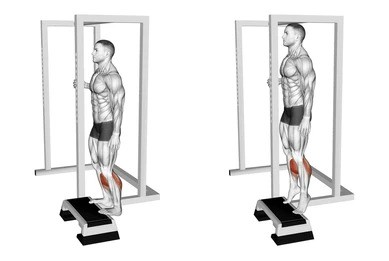
Pay special attention to building the calf muscles.
- Standing on a raised platform, first raise and then drop your heels.
Suggestions:
- Go gently to increase muscle involvement.
- Make a full range of motion.
7. Split Squats using dumbbells
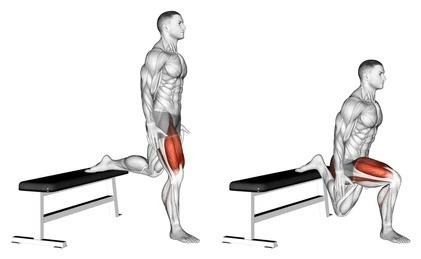
Utilize a stationary lunge to target the quads and glutes.
- Lower your hips while keeping your body straight using one foot forward and the other behind.
Advise:
- Make sure your front knee passes your toes.
- For extra challenges, use dumbbells.
8. Glute bridges using dumbbells

Concentrate on glute isolation.
- Lie on your back, set the dumbbell on your hips, and squeeze your glutes to raise your pelvis.
Advise:
- Ground yourself with your feet flat.
- Hold the top position for a second, and then descend.
Routines for Every Level: Workout
Reaching your fitness objectives requires customizing your dumbbell leg exercise program. Sample exercises for varying degrees of experience and particular training requirements are below.
Beginner Dumbbell Leg Workout
Warm-up: 5-10 minutes of dynamic stretching.
Exercises:
3 sets of 10 Dumbbell Squats
3 sets of 8 Forward Lunges (each leg)
3 sets of 10 Romanian Deadlifts
Cool-down: 5 minutes of stretching.
Intermediate Dumbbell Leg Workout
Warm-up: Dynamic stretches and light cardio.
Exercises:
4 sets of 12 Goblet Squats
3 sets of 10 Reverse Lunges (each leg)
3 sets of 12 Dumbbell Deadlifts
3 sets of 15 Dumbbell Calf Raises
Cool-down: Stretch focusing on the lower body.
Advanced Dumbbell Leg Workout
Warm-up: 10 minutes of dynamic exercises.
Exercises:
5 sets of 15 Dumbbell Split Squats
4 sets of 12 Dumbbell Step-Ups (each leg)
4 sets of 12 Sumo Dumbbell Deadlifts
4 sets of 15 Dumbbell Glute Bridges
Cool-down: Thorough lower body stretching and foam rolling.
Dumbbell Leg Workout for Women
Focus: Sculpting legs and glutes.
Exercises:
3 sets of 12 Goblet Squats
3 sets of 10 Lateral Lunges (each leg)
3 sets of 12 Dumbbell Glute Bridges
Additional Tips: Combine with nutrition tips to support muscle growth and recovery, and be mindful of common myths about women and strength training.
Dumbbell Leg Workout for Men
Focus: Building overall lower body strength.
Exercises:
4 sets of 12 Front Squats
4 sets of 10 Dumbbell Lunges (each leg)
4 sets of 12 Romanian Deadlifts
Additional Tips: Emphasize progressive overload and proper form to maximize strength gains.
Dumbbell Leg Workout for Glute Growth
Focus: Maximizing glute activation and development.
Exercises:
4 sets of 15 Dumbbell Glute Bridges
4 sets of 12 Dumbbell Split Squats
4 sets of 10 Dumbbell Deadlifts (Sumo variation)
Additional Tips: Incorporate glute-specific warm-up drills and use progressive overload strategies.
Common Mistakes to Avoid
Doing dumbbell leg exercises easily leads one to common mistakes, even with the greatest intentions. Here are a few errors to be conscious of:
Poor Form: Not keeping the spine neutral during deadlifts or allowing the knees to collapse during lunges can lead to injury.
Excessive Weight: Lifting too heavy before mastering the form increases the risk of strain and injury.
Neglecting Warm-up/Cool-down: Skipping dynamic warm-ups or cool-down stretches can hinder performance and recovery.
Lack of Variation: Repeating the same exercises without progression can lead to plateaus.
Pro Tip: Put more of quality before quantity. Raise weights gradually; constantly give correct form top priority over more weight.
Safety Advice and Courtesy
Any exercise program calls for your first concern to be your safety. Think about these safety measures:
- Learn the right form for every exercise always.
- If lifting heavy, think about including a spotter or partner.
- Listen to your body; stop right once if you experience any sharp discomfort or pain.
- Keep hydrated; drink water before, during, and following exercises.
- Rest Days: Between workouts, let your muscles heal.
Cool-down and Stretching
After completing your dumbbell leg workout, dedicate 5–10 minutes to cool down. Static stretches focusing on the quadriceps, hamstrings, calves, and glutes can:
- Reduce muscle soreness
- Enhance flexibility
- Aid in recovery
Consider incorporating yoga poses like the pigeon pose or child’s pose to relax your muscles and lower your heart rate.
Section for Frequencies
FAQ Section
How often should I work on dumbbell legs?
Aim for two to three times a week, being sure to give enough time for recovery between exercises.
Can conventional barbell exercises be replaced with dumbbell leg workouts?
A: Indeed, they are a good substitute, particularly for people with limited tools or room. For a balanced training program, both can, however, enhance one another.
Q: Starting with what weight?
Start with a weight so that, for 10 to 15 repetitions, you can keep the correct form. As you strengthen, progressively raise.
Q: Exists a beginner’s modification?
A: Yes. Before increasing to greater weights, beginners should concentrate on perfect form with less weight or even bodyweight workouts.
Conclusion
Whether your training is for functional fitness, muscular development, or body sculpting, dumbbell leg routines provide a complete, adaptable, and powerful means to develop a strong lower body. Incorporating a range of exercises—from deadlifts and step-ups to squats and lunges—you may target different muscle areas, lower your risk of injury, and always challenge your body.
Note:
Whether your program is a beginner’s one, a customized one for men or women, or you want glute development, customize the exercises to fit your particular objectives.
Personalize Your Routine: Whether you’re following a beginner program, a specialized workout for women or men, or aiming for glute growth, tailor the exercises to meet your unique goals.
Focus on Form: Proper technique is critical to maximize benefits and prevent injuries.
Progress Gradually: Increase weights and complexity only as your strength and confidence improve.
Including these dumbbell leg workout ideas in your exercise program improves your physical performance and gives you the knowledge to get long-lasting effects. View our deep-dive articles on certain workouts to improve your technique and find even more specialized routines.
“Fitness is about being better than you used to be, not about being better than someone else.”
See our associated pieces on beginning guidance, nutrition advice, and gradual overload techniques for further ideas and interactive material. Here’s to strengthening a better, healthier lower body and happy training!
Understanding the theory behind these exercises and using this doable advice will help you to reach your goals for lower body strength. Whether your preferred dumbbell leg workout is for men or women or for glute development, consistency and smart practice will clear the road to achievement. Have fun on your path, and keep stretching your boundaries!









